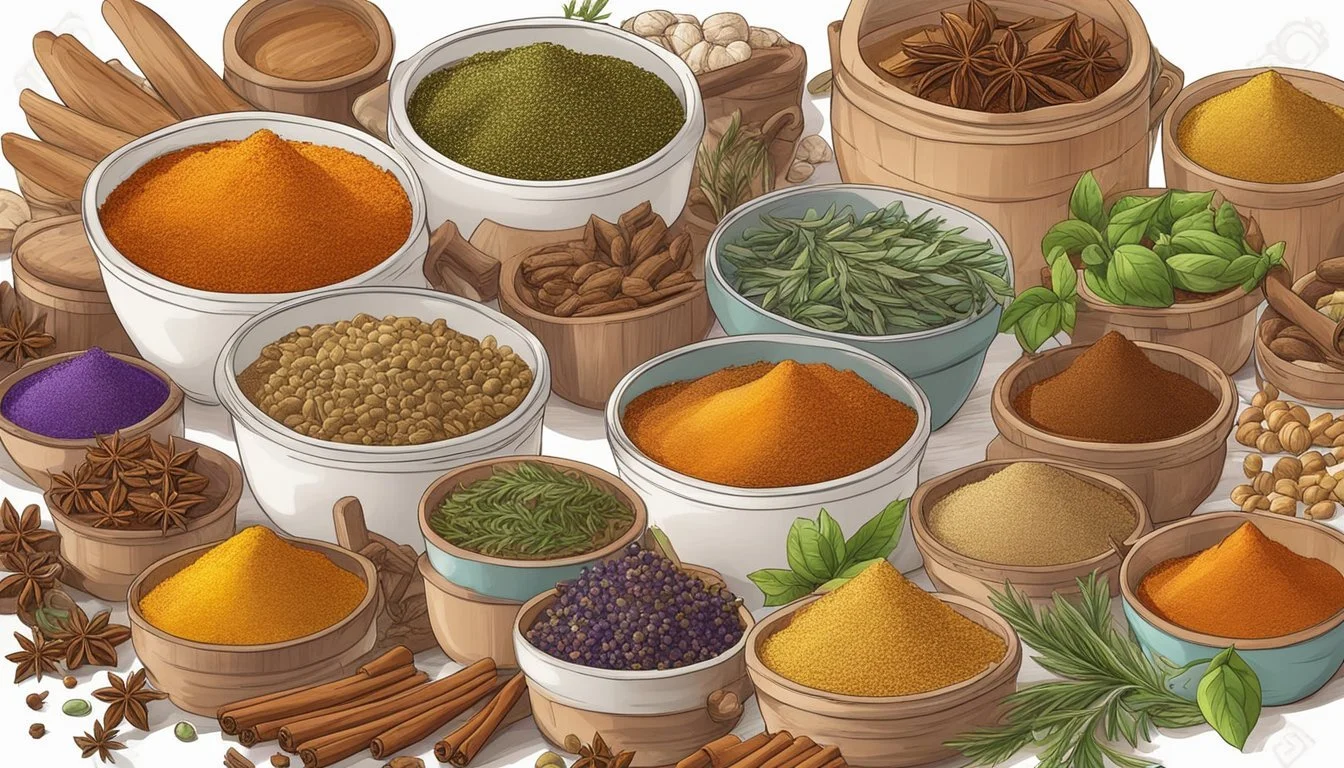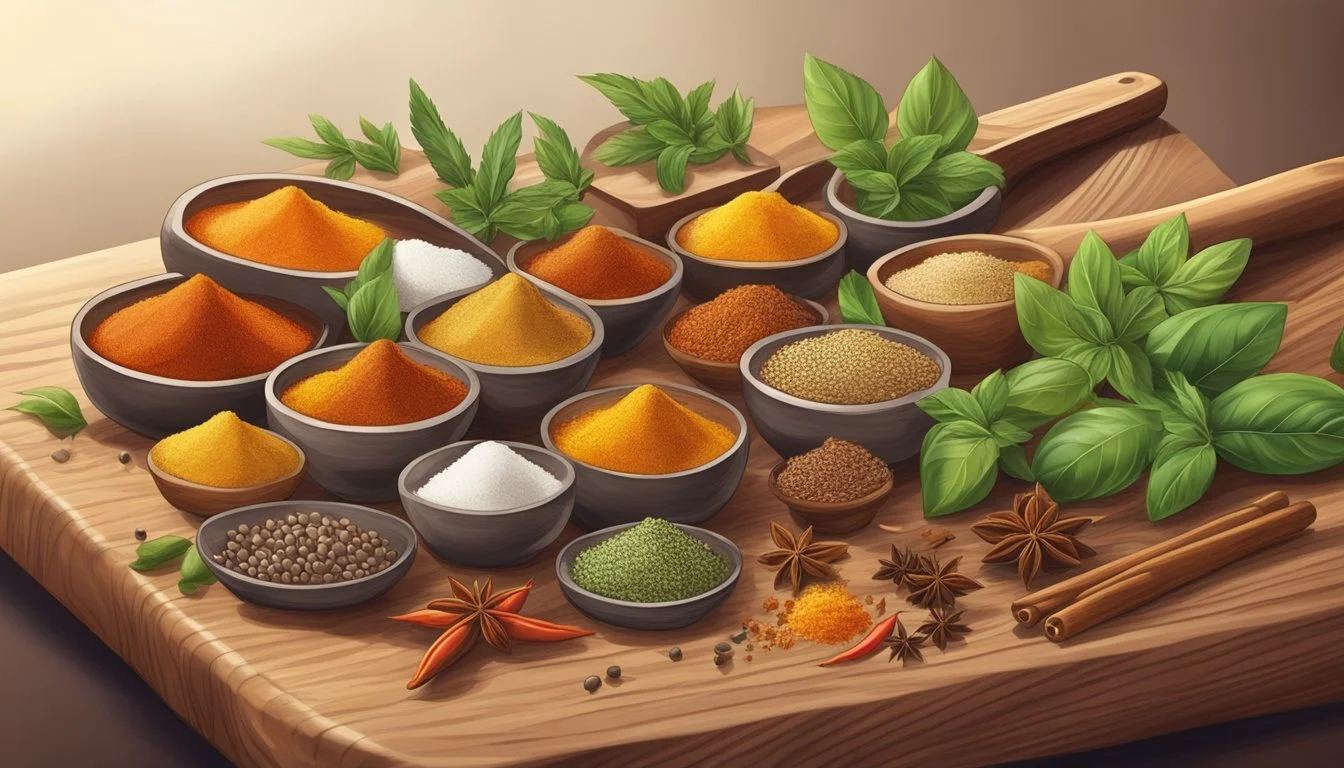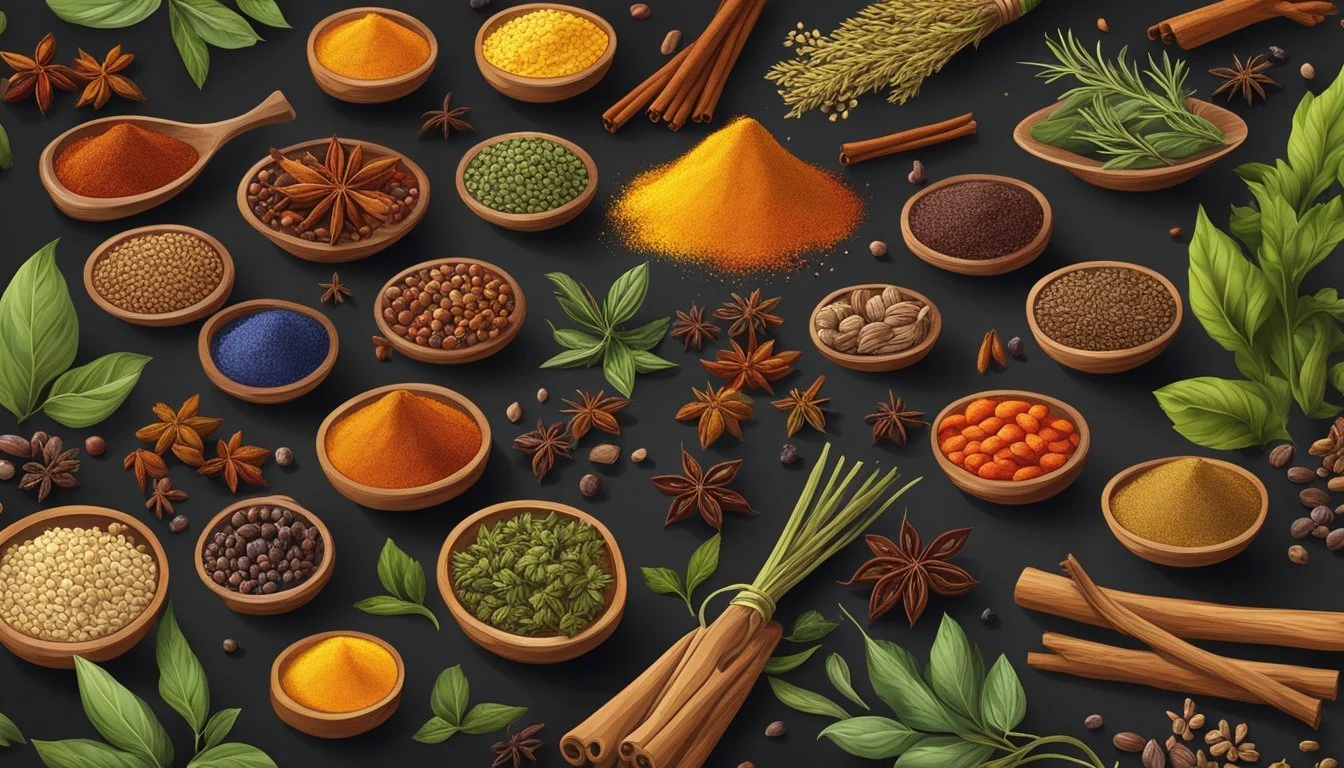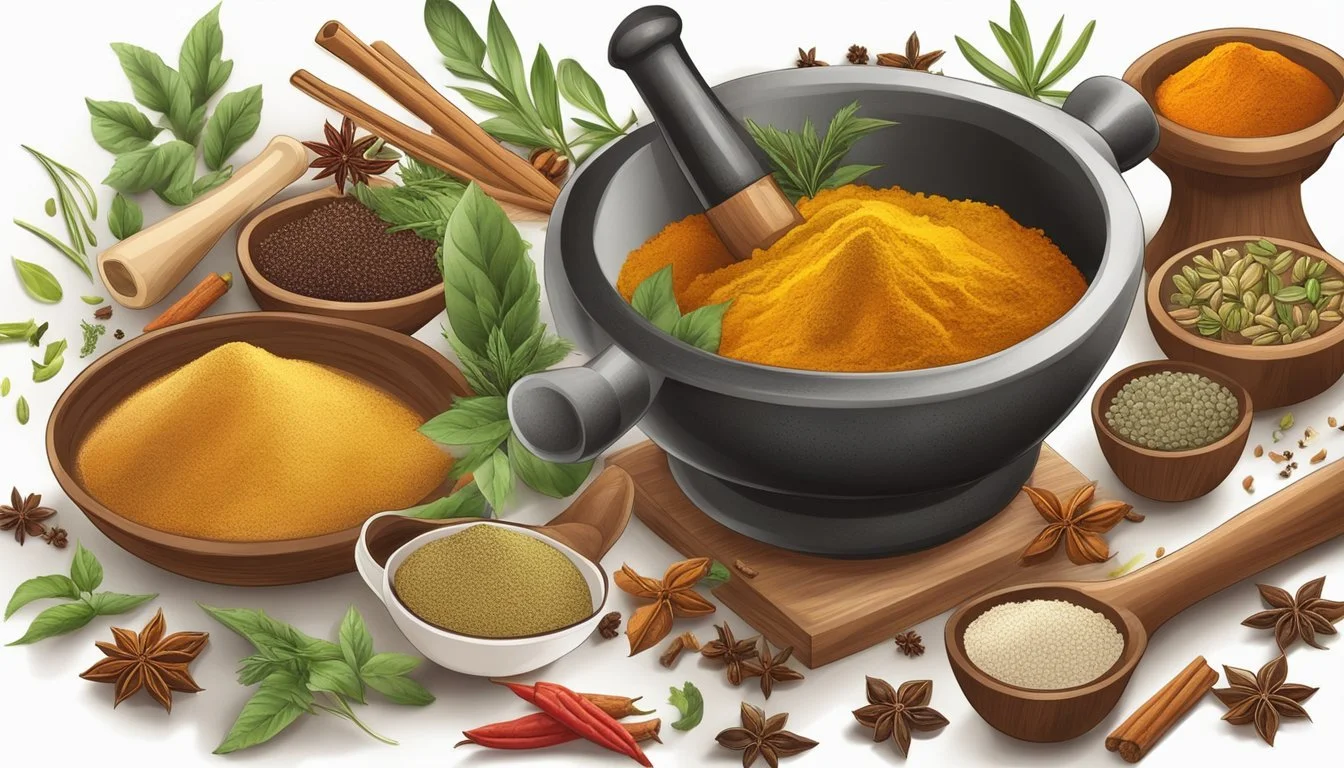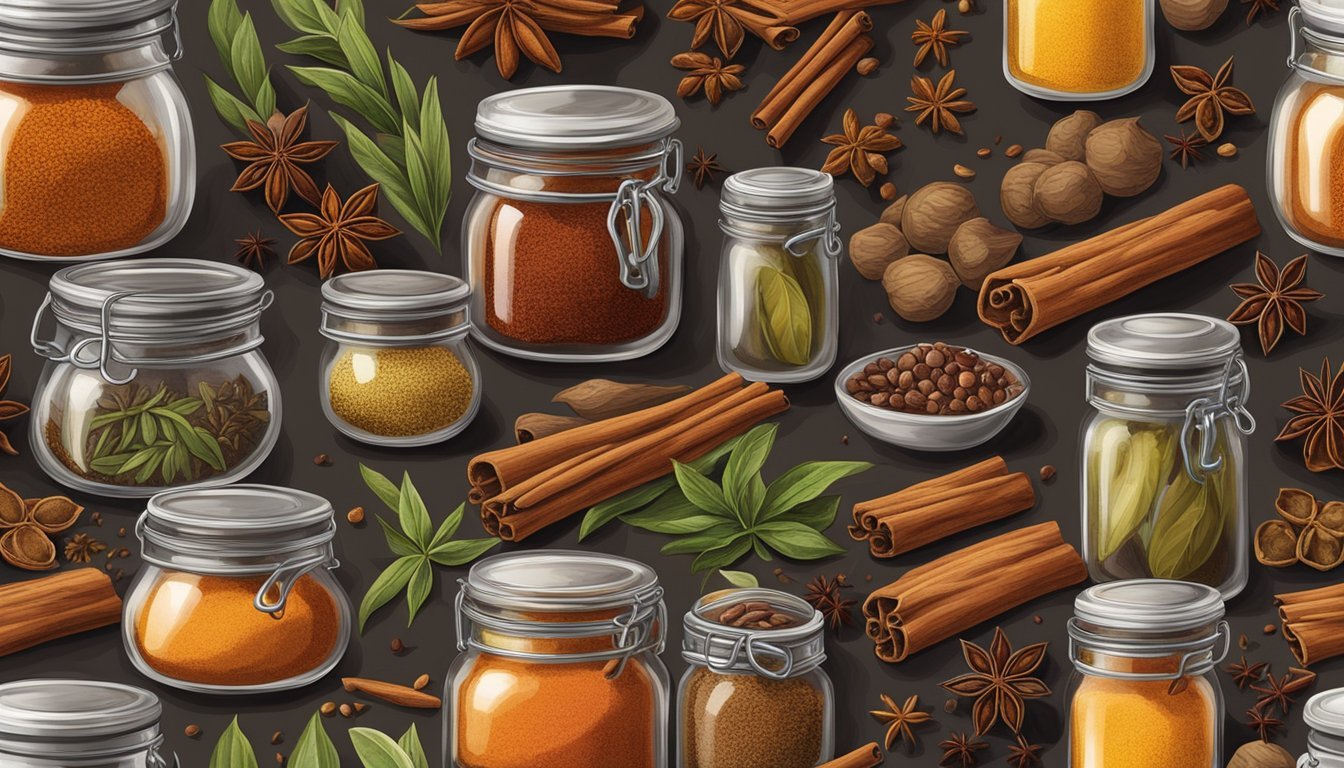Swicy Aromatics
Mastering the Blend of Spices and Herbs for Sweetness Enhancement
The culinary landscape is ever-evolving, and the recent rise of 'swicy'—a portmanteau of sweet and spicy flavors—highlights the creative blending of tastes in contemporary cooking. This trend has seen a significant surge on restaurant menus and in home kitchens, where the balance of sugar and spice not only teases the palate but also magnifies the depth of aromatics in food. Spices and herbs, long revered for their distinct qualities in savory dishes, are being increasingly utilized to enhance the sweetness of desserts and confectioneries.
Aromatic herbs such as basil and floral notes from elements like lemon zest, when introduced into sweet concoctions, contribute a subtle complexity that transforms traditional sweets. Spices like cinnamon and nutmeg, staples in dessert recipes, deliver a warm, comforting aroma and have the ability to elevate the overall flavor profile. Peppercorns and other spices introducing heat can develop an additional layer of taste, making the case for their inclusion in sweet recipes.
As these 'swicy' pairings gain popularity, chefs and enthusiasts are discovering new ways to incorporate aromatic spices and herbs into their dessert offerings. The objective is not only to intrigue the consumer’s senses but also to craft a memorable gustatory experience that marries the unexpected heat with classic sweetness, achieving a balance that stands out in the crowded and diverse world of culinary arts.
The Art of Flavor Balancing
To master the art of flavor balancing is to understand how spices and herbs can enhance the natural sweetness in foods. It is a meticulous practice that involves timing, precise ratios, and an appreciation for how different taste profiles interact.
Understanding Taste Profiles
Taste profiles form the foundation of flavor balancing. They are typically categorized into five primary tastes: sweet, sour, salty, bitter, and umami. When aiming to accentuate sweetness, one must consider how other tastes can either complement or contrast with sweet flavors. For instance, a pinch of salt can make a sweet dish more pronounced, while a hint of bitterness might offer a complex backdrop.
Incorporating Aromatics
Aromatics such as onion, celery, and garlic are the building blocks for creating layers of flavor. Known as the "holy trinity" in Cajun cooking and "mirepoix" in French cuisine, these ingredients are often sweated in oil or butter to release their essence into dishes. When these aromatics soften and meld, they contribute a base sweetness that is integral to a balanced dish.
Layering Flavors
Layering flavors requires introducing various ingredients at different stages of cooking. This technique ensures that each component imparts its unique profile without overpowering the others. Adding spices early on allows them to release their full spectrum of flavors; introducing a spice blend at the close of cooking, however, can offer a head note that defines the dish's finishing touch.
The Role of Heat and Timing
Heat is pivotal in releasing the essential oils in spices and is directly related to timing. To achieve the desired balance, spices need to be cooked at the right temperature and for the appropriate duration. Overheating may lead to bitterness, while insufficient cooking might leave spices tasting raw and pungent.
Spice Blends and Ratios
Spice blends must be carefully constructed with respect to ratios—it's a delicate dance between the quantity of each spice and how they come together to form a cohesive flavor profile. For instance, a blend might contain:
2 parts cinnamon: Sweet and warming
1 part nutmeg: Adds depth with its slightly sweet, nutty flavor
1 part cardamom: Offers a citrusy-sweet zing
Using just the correct amount ensures each spice shines without outshining the others, maintaining the crucial balance necessary for a harmoniously spiced dish.
Sweetness Enhancement Techniques
In the culinary arts, the skillful use of spices and herbs is essential for enhancing sweetness without relying on added sugars. These natural flavor enhancers can transform the taste profile of a dish while maintaining nutritional benefits.
Selecting Sweet-Enhancing Spices
Certain spices are well-regarded for their ability to amplify sweet notes in food. Cinnamon is a prime example; it can be sprinkled on fruits or used in baking to bring forth a natural sweetness. Cloves and star anise also serve this purpose effectively, as they add a warm, licorice-like sweetness ideal for compotes and desserts.
Cinnamon: Enhances natural sugars, perfect for oats or fruit dishes.
Cloves: Add to fruit-based sauces for a deep, sweet spice.
Star Anise: Ideal in poaching liquids for pears or apples.
Herbs That Complement Sweetness
Herbs have the power to elevate a dish's sweet characteristics through their aromatic qualities. Basil, especially varieties like cinnamon basil, pairs beautifully with berries and citrus fruits. Mint is another versatile herb, lending a fresh sweetness to beverages and chocolate desserts (What wine goes well with chocolate desserts?). Tarragon adds a subtle hint of licorice, complementing sweet glazes and sauces.
Basil: Works with citrus flavors, use in fruit salads or lemon desserts.
Mint: Freshens up sweet drinks, fruit salads, and chocolate.
Tarragon: Complements sweet marinades and dressings.
Sweet and Savory Balance
Achieving a balance between sweet and savory flavors can elevate a dish to a complex taste experience. Using spices and herbs that enhance sweetness enables chefs to create nuanced flavor profiles. In savory dishes, a hint of sweetness can be introduced to contrast rich flavors, creating a more rounded and satisfying dish. For example, adding a touch of cinnamon or star anise to a meat marinade can impart a subtle sweetness that complements the savory elements.
Savory dish enhancement:
Cinnamon: Add to marinades for chicken or lamb.
Star Anise: Incorporate into braising liquids for pork or duck.
These techniques not only help to reduce added sugar in cooking but also open up a world of flavor possibilities, making the most of natural sweetness and sophisticated palates.
Spices and Herbs in World Cuisines
In global gastronomy, the use of spices and herbs is critical in defining the signature flavors of ethnic dishes. They not only enhance the taste but also contribute to the cultural identity of cuisines.
Asian Flavor Essentials
The quintessential Asian Trinity of ginger, garlic, and scallions creates a fragrant foundation in many Asian dishes. In Thai cuisine, the vibrant lemongrass imparts a citrusy aroma that is fundamental in Thai curry preparations. Often found in Asian meals, these elements bring forth a harmonious blend of flavors that are at once distinct and complementary.
Essential Components:
Ginger: Adds a warm, zesty kick.
Lemongrass: Lends a fresh lemony scent.
Garlic: Provides a robust base note.
Mediterranean Herbs and Spices
Herbs like oregano, rosemary, and sage are staples in Mediterranean kitchens, where they are utilized to season a wide range of dishes from grilled meats to robust tomato sauces. The liberal use of olive oil as a cooking medium carries these herbs' flavors well, allowing their fragrant notes to shine through in the final dish.
Key Mediterranean Flavorings:
Olive oil: A versatile base for herbs.
Oregano: Bold and earthy, perfect for tomato-based dishes.
Rosemary: A piney aroma that complements meats.
The Spice Palette of Indian Cuisine
Indian cuisine is synonymous with its prolific use of spices. Complex blends, such as garam masala, often incorporate cumin and turmeric, which not only contribute depth to the flavor profile of curries but also possess notable color properties that greatly enhance the visual appeal of meals. These spices define the intricate layers of taste that are typical of Indian dishes.
Fundamental Indian Spices:
Cumin: Earthy, slightly bitter, and warm.
Turmeric: Bright yellow with a mustardy scent.
Creative Aromatic Applications
When infusing sweetness into dishes using spices and herbs, the key is understanding how these elements interact with the primary ingredients to elevate the overall taste.
Perfecting Soups and Stews
In perfecting soups and stews, the right combination of aromatic vegetables and spices can transform a simple broth into a rich tapestry of flavors. A classic mirepoix—a mix of diced carrots, celery, and onions—sautéed in butter establishes a sweet and savory foundation. Pairing with spices such as cinnamon or star anise can further enhance this sweetness, especially in meat-based broths where these spices complement the natural richness.
Enhancing Sauces and Marinades
To enhance sauces and marinades, one must consider the balance between the sweet nuances of aromatics and the core ingredients of the sauce. For tomato-based sauces, (What wine goes well with tomato-based sauces?) adding basil and a pinch of sugar can augment the natural sweetness of the tomatoes. When marinating meats, a combination of soy sauce, brown sugar, and garlic can not only tenderize the protein but also lend a satisfying sweet-and-savory depth.
Vegetable and Protein Pairings
Creative pairings of aromatics with vegetables and proteins can dramatically alter a meal's profile. For instance, roasting bell peppers with a light glaze of honey and thyme brings out their inherent sweetness. Meanwhile, a dry rub of paprika, brown sugar, and cumin on chicken can intensify the flavors and create a caramelized exterior. The key is to allow the spices and herbs to bring out and complement the natural flavors of the vegetables and meats.
Health Benefits and Dietary Considerations
Incorporating spices and herbs into meals can offer significant health benefits, particularly in terms of reducing inflammation and providing flavor alternatives in low-sodium dishes.
Anti-Inflammatory Spices
Certain spices are praised for their anti-inflammatory properties, which can play a crucial role in a culinary artist's palette. Turmeric is one of the most well-known spices in this category, containing curcumin, a compound with potent anti-inflammatory effects. By integrating turmeric into their dishes, culinary artists not only enhance the natural sweetness but also add health value by potentially reducing inflammation-related discomfort.
Low-Sodium Flavoring Options
When it comes to creating flavorful meals without relying on salt, herbs and spices are invaluable tools for the culinary artist. Using spices like cinnamon can add a natural sweetness and depth of flavor, helping to reduce the need for excess sodium. Herbs, often more leafy and plant-like, have a similar capacity to boost the taste profile of a meal while supporting a diet that is lower in sodium. Here is a list of herbs and spices that can enhance sweetness in meals:
Cinnamon: Adds warmth and natural sweetness.
Cloves: Lends a sweet, aromatic flavor.
Nutmeg: Provides a nutty sweetness ideal for desserts and savory dishes.
Utilizing these spices allows for reduced sodium content, catering to dietary needs without compromising on taste.
Storing and Handling Spices and Herbs
When integrating spices and herbs into sweet dishes, it is imperative to understand their flavor potency and how storage affects their shelf life. Proper storage techniques can preserve the color and seasoning qualities of both fresh and dried varieties.
Fresh vs Dried
Fresh herbs typically exhibit vibrant colors and robust flavors, playing a key role in enhancing the sweetness of a dish. However, fresh herbs have a shorter shelf life and are best stored in the refrigerator, wrapped in a slightly damp paper towel, or in a jar with water for herbs like cilantro and mint. They generally last for about a week.
Dried herbs and spices, on the other hand, offer convenience and a concentrated flavor, making them a potent additive for seasoning. Dried spices should be kept in a cool, dark place in airtight containers to prevent moisture from diminishing their boldness. When stored correctly, dried spices can retain their qualities for up to 1-3 years.
Maximizing Flavor Potency
To ensure the highest flavor potency, follow these storage guidelines:
Keep containers away from direct sunlight and heat sources.
Avoid humidity by sealing containers tightly after each use.
Regularly check and refresh your stock; ground spices lose potency faster than whole spices.
A color change often indicates a loss of flavor potency in spices. If the vibrant color begins to fade, it is likely time to replace the spice to maintain the desired effect in sweet dishes. Remember that a spice's impact on seasoning is directly correlated to its freshness and how well it has been stored.
Cooking Techniques and Practices
When integrating spices and herbs to enhance sweetness in dishes, certain techniques are paramount. These practices involve precision and balance, ensuring flavors are enhanced without overwhelming the dish's natural taste.
Mastering the Mirepoix and Trinity
Mirepoix is a classic French technique involving a combination of onions, carrots, and celery. This trio is finely chopped and gently sautéed to provide a sweet and savory flavor foundation for a variety of recipes. Common ratios consist of two parts onion, one part carrot, and one part celery. The mirepoix is not only about the ingredients but also about the cooking process; low and slow cooking allows the natural sugars to caramelize, intensifying the sweetness and complexity in the final dish.
The Cajun trinity closely mirrors the mirepoix but typically substitutes green bell peppers for carrots, accompanied by onions and celery. This mix pinpoints the sweet notes of the peppers and onions, vital for the base of many southern dishes.
Using Sachets and Bouquets
Sachets and bouquets garnis are packages of aromatics and herbs that impart subtle flavors and aromas without leaving traces of the herbs themselves in the dish. A sachet often contains peppercorns, thyme, bay leaf, and sometimes garlic, encapsulated in cheesecloth for easy removal.
Sachet Ingredients Use Peppercorns Adds depth, with a touch of heat Thyme Introduces subtle, earthy tones, perfect for balancing sweetness in a dish Bay Leaf Provides a slight bitterness, enhancing sweet profiles
In contrast, a bouquet garni is typically a bundle of fresh herbs, like thyme, parsley stems, and bay leaf (often referred to as 'blue leaf' due to its silvery-blue hue), which are tied together with a string. As the bouquet simmers, it subtly infuses the dish and can be removed before serving. It's crucial not to overpower the inherent sweetness of the main ingredients, so chefs use it with a measured hand.
Conclusion
In the culinary world, the interplay of herbs and spices with sweetness cannot be overstated. These ingredients serve not just to season but to harmonize and enhance the flavors within a dish. The evidence suggests that sweet and spicy components are not merely complementary; they are mutually beneficial in creating a complex flavor profile.
Herbs like thyme and rosemary bring earthy qualities.
Spices such as cinnamon and peppercorns introduce warmth and heat.
Sweetness has the ability to temper the intensity of spiciness, creating a balanced taste sensation.
The phenomenon where spiciness from hot food brings about endorphin release illustrates the intrinsic reward in swicy flavors. Moreover, the trend indicates a significant consumer lean towards sweet and spicy sauces, affirming the burgeoning popularity of this flavor pairing.
It is evident that swicy aromatics have carved a niche in the culinary scene. They do more than appeal to the palate; through the strategic use of herbs and spices, these flavor profiles can enhance the perception of sweetness in food, potentially allowing for reduced sugar content without compromising taste.
The marriage between sweetness and aromatic spiciness is poised to continue captivating taste buds, as both home cooks and professional chefs embrace the depth and complexity these combinations provide.

